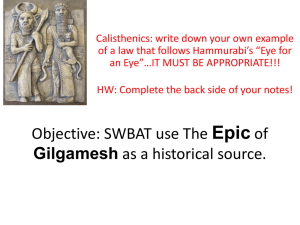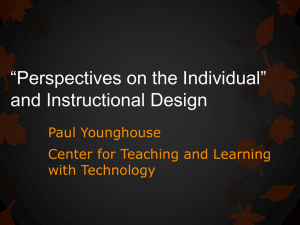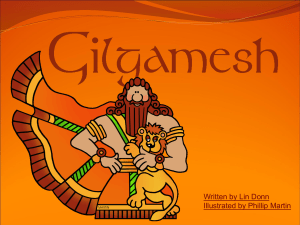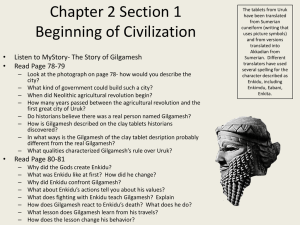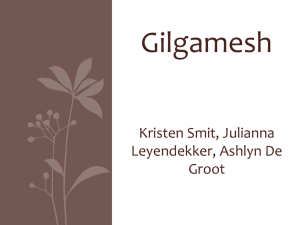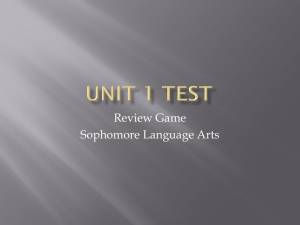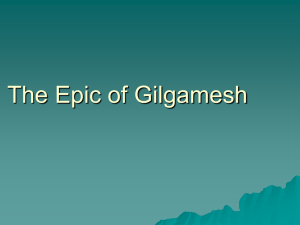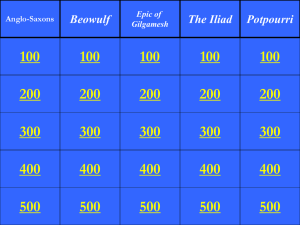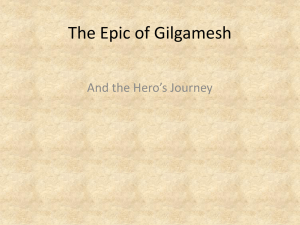Ridella Madi Ridella Abigail Heiniger World Masterpieces April 20th
advertisement
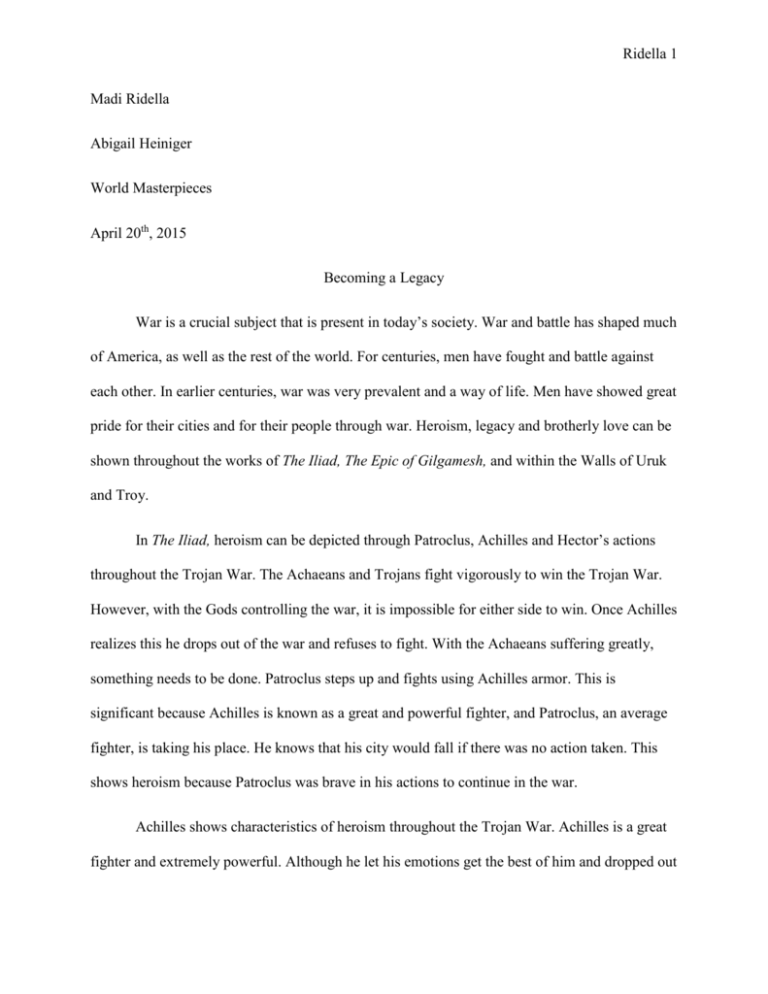
Ridella 1 Madi Ridella Abigail Heiniger World Masterpieces April 20th, 2015 Becoming a Legacy War is a crucial subject that is present in today’s society. War and battle has shaped much of America, as well as the rest of the world. For centuries, men have fought and battle against each other. In earlier centuries, war was very prevalent and a way of life. Men have showed great pride for their cities and for their people through war. Heroism, legacy and brotherly love can be shown throughout the works of The Iliad, The Epic of Gilgamesh, and within the Walls of Uruk and Troy. In The Iliad, heroism can be depicted through Patroclus, Achilles and Hector’s actions throughout the Trojan War. The Achaeans and Trojans fight vigorously to win the Trojan War. However, with the Gods controlling the war, it is impossible for either side to win. Once Achilles realizes this he drops out of the war and refuses to fight. With the Achaeans suffering greatly, something needs to be done. Patroclus steps up and fights using Achilles armor. This is significant because Achilles is known as a great and powerful fighter, and Patroclus, an average fighter, is taking his place. He knows that his city would fall if there was no action taken. This shows heroism because Patroclus was brave in his actions to continue in the war. Achilles shows characteristics of heroism throughout the Trojan War. Achilles is a great fighter and extremely powerful. Although he let his emotions get the best of him and dropped out Ridella 2 of the war, he goes through a transformation near the end. Once his beloved friend, Patroclus dies, Achilles goes into a powerful rage fueled by his grief. Achilles enters back in the war and helps to his city to defeat the Trojans. This took great strength for Achilles to do after he refused to fight. Fueled by his anger, Achilles defeats Hector, winning the war. Still enraged, Achilles disrespects Hector’s body. Then, he puts his emotions aside and returns Hector’s body to the Trojans so they can give him a proper burial. Achilles demonstrates characteristics of heroism because he was a true hero to his city by defeating the Trojans and he paid his respects to the Trojans after the war. Lastly, Hector shows great traits of heroism through his actions in the Trojan War. Hector was also a great fighter and would do whatever it took to win the war. However, his efforts fail him when he makes his men sleep outside the Walls one night. This is done before he knows Achilles is rejoining the war. This was a grave mistake and many of the Trojans suffered as a result. However, throughout all of this Hector goes out there and fights instead of hiding behind the Walls for protection. Hector wanted to die like a hero. During the war he says, Why so much grief for me? No man will hurl me down to Death, against my fate. And fate? No one alive has ever escaped it, neither brave man nor coward, I tell you—it’s born with us the day that we are born (6.579-584). Ridella 3 He explains to Andromache that people are either born a hero or a coward. Although Hector is defeated, he died a fighter, which is what he truly wanted. This makes him a hero because he stayed to fight for his people during Achilles rage when he could have used the Walls as protection. The Trojan Walls are extremely significant to heroism and legacy. The Walls were built for protection and they provided a sense of hope for the Trojans. The Walls are what helped the Trojans from falling from the start of the war since they were so powerful. They represented the progress of the war as well. The story refers back to the Walls throughout the duration of the war to show who is winning at that time. The Walls that still stand represent the Trojan War and the legacy left behind it. Brotherly love can be depicted through The Iliad. Patroclus and Achilles were very close to one another and cared for each other. Once Achilles decided to drop out of the war, Patroclus stepped up. Not only did Patroclus decide to fight, he wore Achilles armor to honor him. Once Achilles heard the fate of his beloved friend Patroclus, he was sent into a terrible rage. Achilles was devastated that his best friend was killed in battle. He used his emotions and used it to fight the Trojans. They were both willing to die for each other. These actions from Patroclus and Achilles show true brotherly love. This is comparable to the themes in The Epic of Gilgamesh. Gilgamesh has characteristics of a hero, yet, in a different way than portrayed in the Iliad. Gilgamesh was not a hero to the people of his city. He disrespected his men and treated the woman however he pleased. Many people were not fond of Gilgamesh but they knew he was too strong and powerful to defeat on their own. Eventually the people cried to the Gods for help to stop Gilgamesh from controlling them. Ridella 4 Gilgamesh was then introduced to Enkidu, which becomes more than his best friend. Enkidu was created to help control Gilgamesh’s power. In contrast, Enkidu was mesmerized by Gilgamesh that he became his partner. The two would go on dangerous adventures even when advised not to by the people of the city and even the Gods. Yet, they would never listen and decided to go on with whatever they had set their minds to. Throughout these adventures is were the two became very closer to one another. Gilgamesh was always a strong-headed, cold-hearted person, until he met Enkidu. He never would have thought that he could love someone the way he did for Enkidu. However, once Enkidu died, it sent Gilgamesh into a Grievance that he never imagined was possible. It was clear that Gilgamesh and Enkidu became brothers to each other throughout the epic. Gilgamesh introduced Enkidu to his mother, which was a huge step for him personally. Throughout the story Gilgamesh and Enkidu create a strong bond. Questions have risen towards the meaning of Gilgamesh and Enkidu’s relationship. It has been compared to David and Jonathon’s relationship in the Jewish Bible. People have questioned if the love for one another was eros instead of phileo. In these classics near Eastern literature, a religion professor, Susan Ackerman, reflects on the characteristic of homoerotism. Yet, labels like ‘gay’ or ‘homosexual’ can be misleading prior to reading the texts (Beckman). The analysis has to go further than that to discover the meaning behind their relationship. Homosexual relationships in Mesopotamian or Israelite society were not accepted. This could have led to the secrets of Gilgamesh and Enkidu’s relationship, similarly to Dave and Jonathon. Susan Ackerman searches for an answer to the never ending question. In the article Beckman writes, “She finds the answer to her paradox in the concept of rite de passage, “rite of passage”” (Beckman). This conceptual framework within these narratives established a “liminal” Ridella 5 period. This means that social norms in society can be evoked or revered when a character goes through a transformation. Beckman write, “She argues that while David is transformed from a simple shepherd to a glorious monarch and while Gilgamesh progresses from glory-seeking superman to wise and responsible ruler, each inhabits a liminal state, marked by the flouting of conventional sexual roles” (Beckman). This “liminal” period can be used to describe the true meaning of Gilgamesh and Enkidu’s relationship. Since Gilgamesh is two-thirds God and only one-third mortal he is very strong and powerful. Yet, Gilgamesh strived to be the toughest and greatest throughout his city. His dream was to become immortal and have his legacy carry on. This is what strived Gilgamesh to go on dangerous adventures because he wanted to be remembered. However, Gilgamesh takes this too far by going on adventures that the Gods advise against, which inevitably leads to his best friend Enkidu’s death. The tale of these adventures describes Gilgamesh’s quest for legacy. One of the first quests that the two go on is their journey to the Cedar Forest. They journeyed for eternal life from Utanapishtim. Throughout their journey they defeat the dreadful creature, Humbaba. This was a huge accomplishment for these two because of the great fear and risk they took to achieve it. Shortly after the Bull of Heaven comes down and claim that there is a blood price for a horrific action such as the one that just took place. In that moment Enkidu dies and it makes Gilgamesh realize that not even he is immortal. Gilgamesh recites, “How can I rest, how can I be at peace? Despair is in my heart. What my brother is now, that shall I be when I am dead. Because I am afraid of death I will go as best I can to find Utnapishtim whom they call the Faraway, for he has entered the assembly of the gods” (Mark). Gilgamesh fears death and craves to be immortal like the Gods. Ridella 6 One of Gilgamesh’s fears is to not be remembered. Gilgamesh knows he is powerful because he is two-thirds divine. However, in the back of his mind he know he does not stand up to the Gods because he is still one-third mortal. Gilgamesh goes on the quests and adventures to prove something to himself. He wants to show himself that he is mighty like the Gods. Yet, with the death of Enkidu, this sparks his greatest fear. From this point on Gilgamesh fights even harder and cries to the Gods to make him immortal. Gilgamesh’s wish doesn’t come true and he realizes that he will have to face death. Gilgamesh wanted to become immortal so he could be remembered throughout his city. Gilgamesh went on these adventures to prove something to himself. Gilgamesh is a hero, not to his city, but to himself. At the end of the epic Gilgamesh comes to terms with death. However, in the end Gilgamesh obtains what he always wanted. Although Gilgamesh didn’t become immortal, he was still remembered and left a legacy on the city because of the Walls. The Walls of Uruk were built by hand by Gilgamesh. They are an extremely powerful symbol of Gilgamesh’s strength. The Walls were built for protection of the city. The Walls are so prevailing that they still stand today. In the article, “The Eternal Life of Gilgamesh”, this theme is analyzed. The article states, “According to the historian D. Brendan Nagle, “This magnificent poem, which deals with such eternal human problems as sickness, old age, death, fame and the craving for the unattainable, can be considered a metaphor for Mesopotamia’s own heroic struggle to resist decay and leave a name for itself among the peoples of Earth”” (Mark). Not only does Gilgamesh’s legacy thrives through his outstanding Walls, he lives on through many more aspects. According to the article, “While Gilgamesh may have failed in his quest for immortality in the Epic and the historical king is known only through passing references, lists and inscriptions, he lives on eternally Ridella 7 through the work of Shin-Leqi-Unninni and the many other, now nameless, scribes who wrote down the orally transmitted tale and translated the story laboriously generation to generation” (Mark). This tale has been passed down for centuries. Gilgamesh’s story lives on because it is a famous epic which is still told today. The Walls of Uruk are exceptional in their quality and strength. Gilgamesh used naturalistic methods to create the Walls and that is what made them what they are. Uruk was a major city in Mesopotamia. The city is mostly famous from The Epic of Gilgamesh. The city has a great number of ‘firsts’ in the development of civilization. According to the article about the City of Uruk, “It is considered the first true city in the world, the origin of writing, the first example of architectural work in stone and the building of great stone structures…”(Mark “Uruk”). This architectural work can be demonstrated through the Walls of Uruk and can be related to the masterpiece Das Geviert by Anselm Kiefer. The work is depicted at the DIA and resembles the strength of the Walls in the city. This work of art is texturized and threedimensional. It gives a realistic and natural representation of the walls that were created hundreds of years ago and still stand today. Uruk was also famous for trade and administration. Some people still don’t know how Uruk became the first city in world. However, historian Gwendolyn Leick wrote, “The Uruk phenomenon is still much debated, as to what extent Uruk exercised political control over the large area covered by the Uruk artifacts, whether this relied on the use of force, and which institutions were in charge…However, it is clear that, at this time, the urbanization process was set in motion, concentrated at Uruk itself” (Mark “Uruk”). The city of Uruk is not only famous for its Walls, but also for much more developing aspects of cities. Ridella 8 The Walls aren’t just strong, but they hold a legacy as well. Throughout the Early Dynastic period which took place between 2900-2334 BCE, the city of Uruk was still a great powerful region. The power of the Wall can be traced back to their history. The article states, “The great wall of Uruk, which was said to have been built by King Gilgamesh himself, still rose around the city when King Eannutum forged his First Dynasty of Lagash in 2500 BCE and established the first empire in the region” (Mark “Uruk”). The Walls were a historical significant and milestone within the city. They stood when the city developed its first empire and still stand today. Another key concept to understand when analyzing Gilgamesh is the Sumerian culture that lies behind it. Oral tradition was a key characteristic of Sumerian culture. This is one major way on how the memory of Gilgamesh lives on today. In ancient Mesopotamia farming was critical for civilization. However, the city was very dry and has very little rainfall. The city relied on irrigation systems for survival. According to the article on Sumerian culture, “Centuries before the beginning of known history, the Sumerians undertook the stupendous task of building embankments to control the floodwaters of the Euphrates River” (“Sumerian Culture”). Architectural characteristics were stepping stones in Sumerian culture for the world’s first cities. Heroism, legacy, and brotherly love can be depicted through The Epic of Gilgamesh, The Iliad, and through the Walls of Uruk and Troy. The characters in the Iliad show characteristics of heroism in their own unique way. Gilgamesh wasn’t a typical hero but he was hero for himself. Brotherly love is another major theme in these epics. Achilles and Patroclus has a strong bond for each other that drove them to help fight the Trojans. Gilgamesh and Enkidu had a strong relationship as well which helped them fight many battles. These two epics also had the theme of Walls and the sense of protection. The Walls of Troy were built for protection while the Walls of Ridella 9 Uruk were a sense of pride strength. All these themes are crucial when analyzing the meaning of these epics. Ridella 10 Works Cited Beckman, Gary. "When Heroes Love: The Ambiguity of Eros in the Stories of Gilgamesh and David (review)." Project Muse. The Johns Hopkins University Press. Web. 29 Apr. 2015. Fagles, Robert. The Iliad. New York, N.Y., U.S.A.: Viking, 1990. Print. Mark, Joshua J. "The Eternal Life of Gilgamesh." Ancient History Encyclopedia. Web. 29 Apr. 2015. Mark, Joshua J. "Uruk." Ancient History Encyclopedia. 28 Apr. 2011. Web. 29 Apr. 2015. "Sumerian Culture." Sumerian Culture. Web. 29 Apr. 2015.
